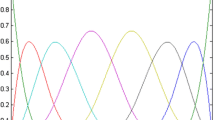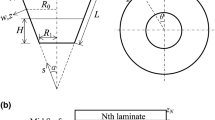Abstract
We developed a computational method for effectively conducting the free vibration analysis of axisymmetric shells with various shapes. This paper describes a computational algorithm for the free vibration analysis of axisymmetric shells using the Sylvester-transfer stiffness coefficient method (S-TSCM). From the free vibration analyses of three axisymmetric shells (joined conical-cylindrical shell, hermetic capsule and built-up shell), we verified the applicability of the S-TSCM. We then confirmed that the computational power of the S-TSCM is much better than both the finite element-transfer matrix method and finite element-transfer stiffness coefficient method, in terms of computational accuracy and time. In particular, when axisymmetric shells are modeled into a large number of conical shell elements, the S-TSCM is superior to both the bisection method using Sturm sequence property and Jacobi method, in terms of computational time and storage.
Similar content being viewed by others

References
S. K. Sen and P. L. Gould, Free vibration of shells of revolution using FEM, Proceedings of the American Society of Civil Engineers, J. of the Engineering Mechanics Division, 100 (EM2) (1974) 283–303.
C. T. F. Ross, Finite element programs for axisymmetric problems in engineering, Ellis Horwood, Chichester, England (1984) 105–115.
M. Özakça and E. Hinton, Free vibration analysis and optimization of axisymmetric plates and shells—I. finite element formulation, Computers & Structures, 52 (6) (1994) 1181–1197.
T. Irie, G. Yamada and Y. Muramoto, Free vibration of joined conical-cylindrical shells, J. of Sound and Vibration, 95 (1) (1984) 31–39.
H. Saunders, E. J. Wisniewski and P. R. Paslay, Vibrations of conical shells, J. of the Acoustical Society of America, 32 (6) (1960) 765–772.
A. Kalnins, Free vibration of rotationally symmetric shells, J. of the Acoustical Society of America, 36 (7) (1964) 1355–1365.
J. Kang, Three-dimensional vibration analysis of joined thick conical-cylindrical shells of revolution with variable thickness, J. of Sound and Vibration, 331 (2012) 4187–4198.
M. S. Tavakoli and R. Singh, Eigensolutions of joined/ hermetic shell structures using the state space method, J. of Sound and Vibration, 100 (1) (1989) 97–123.
L. Tong, Free vibration of orthotropic conical shells, Int. J. Eng. Sci., 31 (5) (1993) 719–733.
M. A. Dokainish, A new approach for plate vibration: combination of transfer matrix and finite-element technique, ASME J. of Engineering for Industry, 94 (1972) 526–530.
M. S. Choi, Free vibration analysis of plate structures using finite element-transfer stiffness coefficient method, JMST, 17 (6) (2003) 805–815.
T. Kondou, T. Ayabe and A. Sueoka, Transfer stiffness coefficient method combined with concept of substructure synthesis method (Linear free and forced vibration analyses of a straight-line beam structure), JSME International Journal (Series C), 40 (2) (1997) 187–196.
T. Kondou, A. Sueoka, K. Yamashita, D. H. Moon and T. Kawamura, Free vibration analysis of a multiple straightline structure regarded as a distributed mass system by the transfer influence coefficient method, JSME International Journal (Series III), 34 (1) (1991) 33–41.
W. H. Press, S. A. Teukolsky, W. T. Vetterling and B. P. Flannery, Numerical recipes, the art of scientific computing, 3rd ed., Cambridge University Press, New York, USA (2007) 447–449.
M. Choi, T. Kondou and Y. Bonkobara, Development of free vibration analysis algorithm for beam structures by combining Sylvester’s inertia theorem and transfer stiffness coefficient method, JMST, 26 (1) (2012) 11–19.
J. W. Demmel, Applied numerical linear algebra, Siam, Philadelphia, USA (1997) 202–203.
A. Sueoka, T. Kondou, D. H. Moon and K. Yamasita, A method of vibrational analysis using a personal computer (A suggested transfer influence coefficient method), The Memoirs of the Faculty of Engineering, Kyushu University, 48 (1) (1998) 31–46.
K. J. Bathe, Finite element procedures, Prentice-Hall, New Jersey, USA (1996) 943–945.
K. J. Bathe, Finite element procedures, Prentice-Hall, New Jersey, USA (1996) 912–919.
E. Efraim and M. Eisenberger, Exact vibration frequencies of segmented axisymmetric shells, Thin-Walled Structures, 44 (2006) 281–289.
M. A. Kouchakzadeh and M. Shakouri, Free vibration analysis of joined cross-ply laminated conical shells, International J. of Mechanical Sciences, 78 (2014) 118–125.
Author information
Authors and Affiliations
Corresponding author
Additional information
Recommended by Associate Editor Ohseop Song
Myung-Soo Choi received his B.S. and M.S. from National Fisheries University of Pusan, Korea, in 1992 and 1994, respectively. He then received his Ph.D. from Pukyong National University in 1999. Dr. Choi is currently an Associate Professor at the Department of Maritime Police Science at Chonnam National University in Yeosu, Korea. His research interests include mechanical vibration, structural dynamics, and optimum design.
Takahiro Kondou received his B.E., M.E. and Dr. Eng. from Kyusyu University, Japan, in 1978, 1980 and 1987, respectively. Dr. Kondou is currently a Professor at the Department of Mechanical Engineering, Faculty of Engineering, Kyushu University in Fukuoka, Japan. His research interests include dynamics of machinery, mechanical vibration and optimum design.
Hee-Jong Choi received his B.S. and M.S. from Pukyong National University, Korea, in 1996 and 1998, respectively. He then received his Ph.D. from Pusan National University, Korea, in 2004. Dr. Choi is currently an Associate Professor at the Department of Naval Architecture and Ocean Engineering at Chonnam National University in Yeosu, Korea. His research interests include fluid mechanics, offshore structure design and optimum design.
Rights and permissions
About this article
Cite this article
Choi, MS., Kondou, T. & Choi, HJ. Free vibration analysis of axisymmetric shells with various shapes using Sylvester-transfer stiffness coefficient method. J Mech Sci Technol 29, 2755–2766 (2015). https://doi.org/10.1007/s12206-015-0604-1
Received:
Revised:
Accepted:
Published:
Issue Date:
DOI: https://doi.org/10.1007/s12206-015-0604-1



